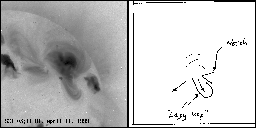

Sorry for the hasty sketch! This shows a "lazy loop," defined as one lying so far away from the vertical as to be almost horizontal. The arrow on the left points roughly at disk center, and the arrow in the lazy loop is meant to bisect it in its (assumed) plane. A line vertical to the solar surface must project to disk center, so to the extent that this "lazy loop" is at all well-behaved geometrically (ideally it's planar and semicircular), it is tilted far away from the local vertical. Above the lazy loop, but below the mass of the active region, one can see the notch. It is a gap in the illuminated coronal field, ie one for which loops visible to SXT (ie, at temperatures above about 2 MK) do not occur.
By way of orientation, the "notch" morphology probably is described elsewhere in other contexts. Frequently an active region will have the appearance of a Conestoga wagon, with large tilted ribs at either end; eruptions and CME precursors often have the Ron Moore's Elbows syndrome, in which the dramatic motions take place bilaterally and avoid what Ron thinks of as the "tie-down" field at the core of the active region.
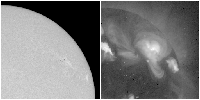
One can see (faintly) the small sunspots of NOAA active region 8308
(the region area was only 60 millionths of the hemisphere on April 13),
located roughly coincident with the notch. So, the conjecture that the
notch corresponds to strong "core" fields seems consistent with the appearance.
The next question: why is the notch so invisible to SXT? It is of course
because there is no high-temperature material there with enough pressure
to radiate soft X-rays; on the other hand, is there heating anyway, but
to a lower temperature? In other words, could the plasma beta (ratio of
gas pressure to magnetic pressure) be comparable as one goes along horizontally
on the axis of the Conestoga wagon (ie, flying above the probable neutral
line)? This would have some implications for coronal heating. Frequently,
for example, theorists (who often feel as though they have to assume something!)
might guess that coronal heating would scale as, say, B2. So
let us look at the EIT data, from lower temperatures, and see if we can
see the notch.
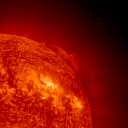 |
 |
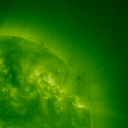 |
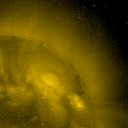 |
From left to right, in the usual EIT colors, and in ascending order of best temperature: HeII, FeIX, FeXII, FeXIV
Sure enough, the notch remains empty in each of the EIT filters. The
304 (He II) filter (left) - seen in its original full resolution - shows
dark counterparts of the "lazy loops". The 171 and 195 filters (center
two) show a bright fan originating to the west (right) of the notch, no
doubt relevant in some way. But by and large the EIT images establish that
little cooler material is adding much gas pressure; if there were still
hotter material Yohkoh would see it, so we conclude that the notch
really does represent a drastic dropout in the coronal plasma beta, just
above the core of the active region. We hesitate to compare Flagstaff,
Arizona to the core of an active region, but anyway here's a picture of
the Grand Canyon:

The implication might be that our "science nugget" conclusions are as solid as a rock!
April 24, 1999: Hugh Hudson
(hudson@isass0.solar.isas.ac.jp)